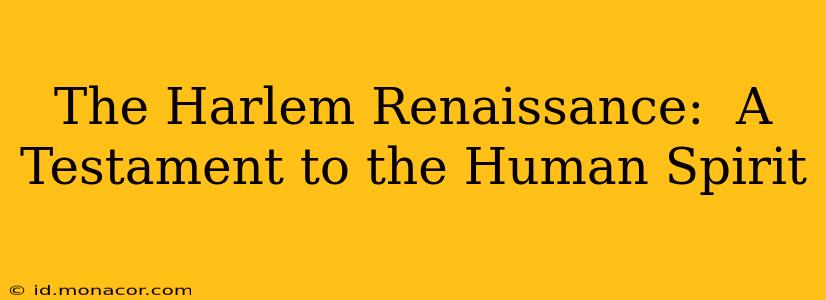The Harlem Renaissance, a period of unprecedented Black artistic, literary, and intellectual flourishing in the 1920s and 30s, stands as a powerful testament to the resilience and creativity of the human spirit. More than just a cultural movement, it was a social and political awakening, a vibrant explosion of talent that irrevocably changed the landscape of American art and culture. This era, centered in Harlem, New York City, saw the rise of iconic figures who challenged racial stereotypes, celebrated Black identity, and laid the groundwork for future civil rights movements. Their work continues to resonate deeply today, inspiring artists and activists alike.
What Defined the Harlem Renaissance?
The Harlem Renaissance wasn't a neatly defined event with clear start and end dates. Instead, it was a complex confluence of factors that fueled a creative explosion. It was characterized by a mass migration of African Americans from the rural South to the urban North, seeking better economic opportunities and escaping the oppressive Jim Crow laws of the South. This "Great Migration" brought a wealth of talent and cultural richness to Harlem, creating a fertile ground for artistic expression. The burgeoning community fostered a sense of collective identity and empowerment, providing the impetus for groundbreaking works in literature, music, art, and theater.
What were the major achievements of the Harlem Renaissance?
The achievements of the Harlem Renaissance are vast and far-reaching. The movement gave rise to a distinct literary voice, producing iconic figures like Langston Hughes, Claude McKay, and Zora Neale Hurston. Hughes's poetry, capturing the rhythms and realities of Black life in America, became synonymous with the era. McKay's powerful novels and poems explored themes of racial pride and protest, while Hurston's anthropological studies and novels offered rich portrayals of Black life in the South and the Caribbean.
Beyond literature, the Renaissance saw a flourishing of musical talent. The blues, jazz, and gospel music scenes thrived, with artists like Louis Armstrong, Duke Ellington, and Bessie Smith pushing the boundaries of musical innovation. Their music transcended racial barriers, influencing the broader American musical landscape and achieving international recognition. Visual arts also flourished, with artists like Aaron Douglas creating striking imagery that reflected the spirit and energy of the era.
What were the key themes explored during the Harlem Renaissance?
The key themes explored during the Harlem Renaissance reflected the multifaceted experiences of Black Americans. Central among these were:
-
Black Identity and Pride: Artists and writers celebrated Black culture, history, and heritage, challenging the negative stereotypes perpetuated by white society. This involved a reclaiming of African heritage and a proud assertion of Black identity.
-
Racial Inequality and Discrimination: Despite the celebration of Black culture, the movement also confronted the harsh realities of racism and discrimination. Many works directly addressed the injustices faced by African Americans, advocating for equality and social justice.
-
The Search for Identity: The migration to the North presented many with a search for a new identity, straddling two worlds—the old South and the new North. This internal struggle played a significant role in much of the era's artistic output.
-
The Power of Community: Harlem itself became a symbol of hope and community, a place where Black Americans could build a new life and create a vibrant cultural center. The strength found in collective identity was a powerful driving force.
What is the lasting legacy of the Harlem Renaissance?
The Harlem Renaissance's legacy extends far beyond its historical context. Its impact continues to be felt today in various aspects of American society:
-
Artistic Influence: The artistic innovations of the period continue to inspire artists across various disciplines. The styles, themes, and techniques developed during this era are still studied and emulated.
-
Social and Political Impact: The movement's challenge to racial inequality helped pave the way for future civil rights struggles. The voices raised during the Harlem Renaissance laid the groundwork for future generations to fight for equality and justice.
-
Cultural Preservation: The celebration and documentation of Black culture during the Harlem Renaissance helped preserve and transmit invaluable aspects of heritage.
The Harlem Renaissance was more than just a cultural movement; it was a powerful statement about the human spirit's capacity for resilience, creativity, and hope in the face of adversity. Its contributions to American culture remain profound and its message of empowerment and equality continues to resonate today.

